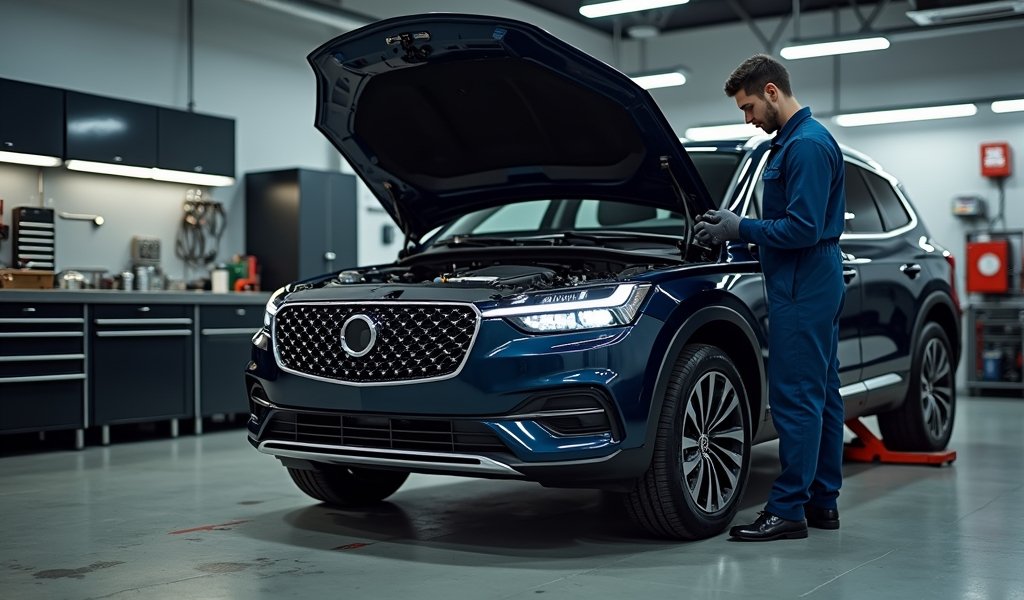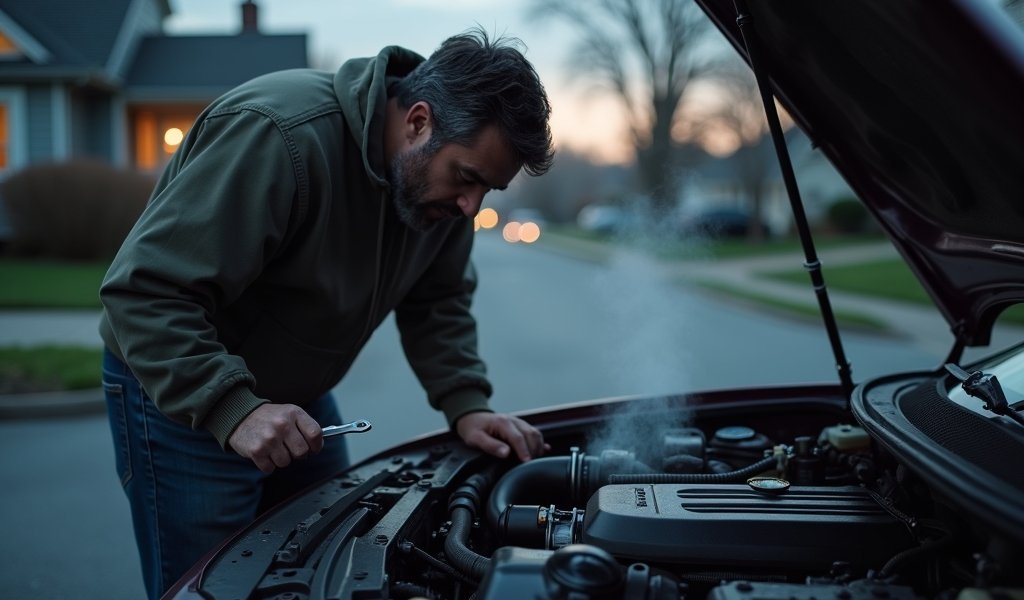Overview
This article provides an in-depth guide to EGR cooler bypass valves, explaining their function in controlling exhaust gas flow, common symptoms of failure (including check engine lights and performance issues), and offering both DIY repair options and prevention strategies. It compares the costs of self-repairs ($60-250) versus professional service ($200-600), while emphasizing the importance of timely intervention to avoid more serious engine problems and maintain optimal emissions control.
Table of Contents
- Understanding the EGR Cooler Bypass Valve
- 5 Signs of EGR Cooler Bypass Valve Failure
- DIY Fixes for EGR Cooler Bypass Valve Issues
- When to Seek Professional Repairs
- Prevention Tips to Extend EGR Cooler Bypass Valve Life
- Cost Analysis: DIY vs. Professional Repair
- Conclusion
- Frequently Asked Questions
Understanding the EGR Cooler Bypass Valve
The EGR cooler bypass valve plays a crucial role in your vehicle’s emission control system. Working in tandem with the exhaust gas recirculation valve, this component helps regulate the temperature of exhaust gases before they’re recirculated back into the combustion chamber. Think of it as the traffic controller for your engine’s exhaust flow.
When functioning properly, the bypass valve directs exhaust gases through the EGR cooler during normal operating temperatures. This cooling process is essential for reducing nitrogen oxide (NOx) emissions and improving fuel efficiency. However, when the engine is cold or operating under specific conditions, the bypass valve redirects exhaust flow around the cooler to maintain optimal engine temperature.
Modern vehicles, especially diesel engines, rely heavily on this system to meet stringent emission standards while maintaining performance. According to DieselNet’s technical resources, a properly functioning EGR system can reduce NOx emissions by up to 60% in some applications.
The bypass valve itself consists of a housing, valve plate, spring mechanism, and an actuator (either vacuum-operated or electronically controlled). These components work together to respond to signals from your engine’s computer, opening and closing based on factors like engine temperature, load, and speed.
Understanding how this system works is the first step toward effective troubleshooting when problems arise. And trust me, as a mechanic who’s seen countless EGR systems fail in creative ways, identifying the right fix can save you both time and money.
5 Signs of EGR Cooler Bypass Valve Failure
When your EGR cooler bypass valve starts acting up, your vehicle has ways of letting you know. Here are the five most common symptoms you might encounter:
First off, the check engine light is often your first clue. Modern vehicles are pretty chatty when something’s wrong, and a malfunctioning bypass valve will trigger error codes related to the EGR system. Don’t ignore that little glowing reminder on your dashboard – it’s trying to help you avoid bigger problems down the road.
Next, you might notice a drop in fuel economy. When the bypass valve fails, exhaust gases might not be properly routed or cooled, affecting combustion efficiency. If you’re suddenly making more frequent trips to the gas station, your bypass valve could be the culprit.
Engine performance issues are another telltale sign. This could manifest as rough idling, hesitation during acceleration, or even random stalling. These symptoms occur because the improper mixing of exhaust gases with the intake air disrupts the carefully calibrated air-fuel ratio your engine needs.
Overheating problems often accompany bypass valve failures. When the valve sticks in the closed position, exhaust gases are constantly routed through the EGR cooler, potentially overwhelming it and leading to engine overheating causes that can damage other components.
Finally, unusual exhaust smells or excessive smoke from the tailpipe might indicate that exhaust gases aren’t being properly processed. This is particularly noticeable in diesel engines, where a failed bypass valve can contribute to that distinctive black smoke we’ve all seen trailing behind struggling trucks.
Keep in mind that these symptoms can also indicate other issues, so proper diagnosis is essential. The Environmental Protection Agency emphasizes the importance of maintaining emission control systems not just for vehicle performance but for air quality and public health.

DIY Fixes for EGR Cooler Bypass Valve Issues
Ready to roll up your sleeves and tackle this problem yourself? Let’s explore some proven DIY fixes for common EGR cooler bypass valve issues. Before starting, make sure your engine is cool and you’ve disconnected the battery for safety.
1. Cleaning the Valve
Carbon buildup is often the primary culprit behind bypass valve failures. A thorough cleaning can sometimes restore proper functionality:
- Locate the bypass valve (usually near the EGR cooler on the engine)
- Remove the valve carefully, following your vehicle’s service manual
- Clean all carbon deposits using a carburetor cleaner and soft brush
- Pay special attention to the valve plate and seating surfaces
- Ensure all moving parts move freely before reinstallation
This simple maintenance can often restore proper operation without replacement parts. I’ve seen valves so caked with carbon they looked like geological specimens, yet they worked perfectly after a good cleaning.
2. Actuator Adjustment or Replacement
If your bypass valve uses a vacuum actuator, check the vacuum lines for leaks, cracks, or disconnections. A failing actuator can prevent the valve from opening or closing properly:
- Inspect all vacuum lines connected to the actuator
- Apply vacuum to the actuator using a hand pump to test functionality
- Adjust the actuator if your model allows for it
- Replace the actuator if it’s not responding correctly
For electronically controlled valves, use a multimeter to check for proper resistance and signal from the engine control module.
3. Sensor Checks
Sometimes the valve itself is fine, but the sensors telling it when to operate are faulty. The engine coolant temperature sensor often influences bypass valve operation. Check sensor connections and replace if necessary.
4. Software Updates
Modern vehicles sometimes need a software update to resolve EGR system issues:
- Check with your dealer about any available ECM updates
- Some aftermarket diagnostic tools can identify if your vehicle needs programming
This is especially relevant for newer diesel engines with complex emission control systems.
5. Bypass Valve Replacement
If cleaning and adjustments don’t solve the problem, replacement might be necessary:
- Purchase the correct replacement part for your specific vehicle model
- Follow removal procedures in your service manual
- Ensure proper torque specifications during installation
- Reset any fault codes after replacement
Remember, these DIY fixes are best attempted if you have some mechanical experience. Always consult your vehicle’s service manual for specific procedures and safety precautions.
When to Seek Professional Repairs
While I’m all for DIY repairs when possible, there are definitely situations where calling in the professionals makes more sense. Let’s talk about when it’s time to wave the white flag and book an appointment with your trusted mechanic.
Complex integration issues should be your first consideration. In many modern vehicles, the EGR system is tightly integrated with multiple engine management systems. If diagnostics show problems extending beyond just the bypass valve, professional tools and expertise become invaluable. Technicians have access to manufacturer-specific diagnostic equipment that can pinpoint the exact issue within interconnected systems.
Warranty concerns are another important factor. If your vehicle is still under warranty, DIY repairs might void your coverage. Manufacturer warranties typically require service by certified technicians using approved parts and procedures. The potential savings from DIY work can quickly evaporate if you lose warranty protection on major components.
Specialized tools requirements can also make professional repair the more practical choice. Some EGR systems require proprietary tools for proper service, especially in newer diesel applications. These specialized tools can be expensive for one-time use and may not be readily available to the average home mechanic.
Time constraints matter too. While DIY repairs can be satisfying, they typically take longer if you’re not doing them regularly. Professional shops have the advantage of experience, proper equipment, and efficient workflows. If your vehicle is your daily driver, the faster turnaround from a professional shop might outweigh the cost savings of DIY.
Safety concerns should never be overlooked. EGR systems operate with hot exhaust gases and are often located in cramped engine compartments. Professional technicians are trained in proper safety procedures and have the equipment to handle these challenges safely. Your safety is worth more than the money saved on a repair.
When selecting a professional shop, look for ASE certification and experience with your specific make and model. A good shop will provide a detailed explanation of the problem and a clear estimate before beginning work.
Prevention Tips to Extend EGR Cooler Bypass Valve Life
An ounce of prevention is worth a pound of cure, especially when it comes to EGR system components. Let’s explore some practical tips to help extend the life of your EGR cooler bypass valve and avoid those frustrating breakdowns.
Regular maintenance is your first line of defense. Following your vehicle’s recommended service schedule is crucial for EGR system health. This includes timely oil changes with the correct oil type for your vehicle. Quality engine oil helps reduce carbon buildup throughout the engine, including EGR components.
Fuel quality matters more than you might think. Using high-quality fuel can significantly reduce carbon deposits that often cause bypass valve issues. For diesel engines, premium diesel fuels with cleaning additives can help keep the entire EGR system cleaner longer. Consider adding a fuel system cleaner occasionally, especially if you’ve been using lower-grade fuels.
Driving habits have a surprising impact on EGR component longevity. Short trips where the engine never fully warms up can accelerate carbon buildup. When possible, combine errands into longer trips to allow your engine to reach optimal operating temperature. This helps the combustion process complete more fully, reducing deposits.
Periodic system cleaning can prevent major issues. Even with good maintenance habits, some carbon buildup is inevitable. Consider an EGR system cleaning every 30,000 miles or so, depending on your driving conditions and fuel quality. This preventative measure can save you from more expensive repairs down the road.
Early intervention at the first sign of issues is perhaps the most important prevention tip. When you notice any of the symptoms we discussed earlier, address them promptly before they cascade into bigger problems. That check engine light might seem annoying, but it’s actually your car’s way of asking for help before things get worse.

Cost Analysis: DIY vs. Professional Repair
Let’s talk money – after all, that’s often the deciding factor when choosing between DIY and professional repairs. Understanding the true costs of both options will help you make an informed decision that’s right for your situation.
DIY Repair Costs
The parts cost for an EGR cooler bypass valve varies widely depending on your vehicle. For most mainstream models, expect to pay between $50-150 for the valve itself if replacement is necessary. If you’re only performing cleaning or adjustment, your costs might be limited to cleaning supplies ($10-20) and basic tools.
Speaking of tools, this is where hidden costs can add up. While basic hand tools might suffice for some vehicles, others require specialized tools for access or adjustment. If you don’t already own these, factor in $30-100 for proper tools depending on complexity.
Diagnostic equipment represents another potential expense. Without proper diagnostic tools, you might be shooting in the dark. Basic OBD2 scanners start around $30, but those with manufacturer-specific capabilities can run $100-300.
Your time has value too. A typical DIY bypass valve repair might take 2-4 hours for someone with moderate mechanical experience. If you’re learning as you go, budget for twice that time.
Professional Repair Costs
Labor rates at professional shops typically range from $80-150 per hour depending on your location and whether you choose a dealership or independent shop. Most shops charge 1-3 hours of labor for bypass valve service.
Parts costs at professional shops will be higher than retail – that’s how they make money. Expect a 30-100% markup on parts compared to what you’d pay directly.
Diagnostic fees are standard at most shops, typically $80-150, but this might be waived if you proceed with repairs. Some shops also include warranty coverage for their work, which adds value.
The Bottom Line
For a typical EGR cooler bypass valve repair:
- DIY total: $60-250 plus your time
- Professional total: $200-600 including diagnostics
While DIY is clearly cheaper on paper, remember to factor in the potential costs of mistakes, additional wear if the repair isn’t done correctly, and the value of your time. For those with mechanical aptitude and the right tools, DIY makes financial sense. For others, the peace of mind from professional work might be worth the premium.
Conclusion
Taking care of your EGR cooler bypass valve doesn’t have to be a headache-inducing experience. Whether you choose the DIY route or prefer leaving it to the professionals, understanding how this system works puts you in a better position to make informed decisions about your vehicle’s maintenance.
Remember that early intervention is key – those initial symptoms we discussed are your car’s way of raising a hand for help before problems escalate into major repairs. Regular maintenance and quality fuel choices go a long way toward preventing issues in the first place.
For the mechanically inclined, tackling bypass valve issues can be both satisfying and cost-effective. Just be sure you have the right tools, information, and safety measures in place before diving in. And if you’re not comfortable with the repair, there’s absolutely no shame in seeking professional help – sometimes that’s the most economical choice in the long run.
Your vehicle’s emission control system isn’t just about passing inspections or avoiding check engine lights – it plays an important role in fuel efficiency, engine longevity, and environmental impact. By giving your EGR system the attention it deserves, you’re making a small but meaningful contribution to cleaner air while potentially saving money on fuel and future repairs.
So whether you’re cleaning carbon deposits this weekend or scheduling an appointment with your trusted mechanic, you’re now equipped with the knowledge to approach EGR cooler bypass valve issues with confidence rather than confusion.
Frequently Asked Questions
What exactly does an EGR cooler bypass valve do?
It controls the flow of exhaust gases, directing them either through or around the EGR cooler based on engine conditions. This helps optimize emissions control and engine performance across different operating temperatures.
How often should I clean my EGR bypass valve?
For most vehicles, cleaning every 30,000-50,000 miles is sufficient unless you notice symptoms earlier. Drivers who frequently make short trips or use lower-quality fuels may need more frequent cleaning.
Can I drive with a faulty EGR cooler bypass valve?
While your vehicle may still run, it’s not recommended as it can cause decreased fuel economy, increased emissions, and potential engine damage. Best to address the issue promptly when symptoms appear.
Will a bad bypass valve cause my check engine light to come on?
Yes, in most modern vehicles the engine control module monitors EGR system performance. A malfunctioning bypass valve will typically trigger diagnostic trouble codes and illuminate the check engine light.
Is EGR cooler bypass valve replacement covered under warranty?
It depends on your specific warranty coverage and vehicle age. Many manufacturers consider the EGR system a part of the emissions control system, which may have extended warranty coverage beyond the basic powertrain warranty.

